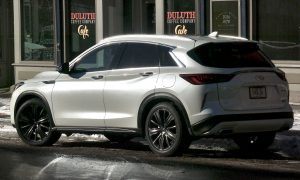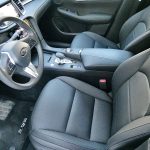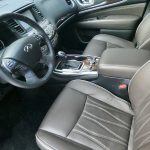QX50, QX60, carry Nissan from here to Infiniti
By John Gilbert
If Nissan decided to produce a book on its engineering, it might call it “From Here to Infiniti.” That would put Infiniti, Nissan’s upscale brand, front and center, which would be appropriate, because Infiniti seems to get first crack at all of Nissan’s considerable engine-building ventures.
For example, Infiniti has a whole posse of SUVs, identified by the letters “QX,” as opposed to its stable of cars, which are all designated by “G” and then a number. The SUVs range from the compact QX30, to the QX50, QX60 and QX80 at the excessively large end.
I recently had the chance to spend a week with the excessively sleek QX50, which might have lifted itself to my favorite status among all the Nissan/Infiniti SUVs. I’m not overlooking the smaller — some might say cramped — QX30, but the QX50 is roomier and armed with a couple of special assets I like a lot.
A month or so before my winter test week with the QX50, I also drove the QX60, which is larger and an excellent choice if you want or need a third row of seating for stowing kids or relatives or neighbors. At $48,150, the QX60 is only a couple thousand more expensive than the $46,100 QX50, until you load up with options. The sticker on the QX60 zoomed up to $61,930, although those options turned the interior from efficient to opulent in short order.
Comparatively, the QX50 topped out at $49,630 and wasn’t nearly as feature-filled as the QX60, but I wouldn’t need the third-row seat and I could think of a few options for the $1,200 difference. Both vehicles have LED lights and all the connectivity functions.
Both the QX50 and QX60 are sleekly styled and sporty, with the Infiniti corporate grille adorning both. The QX50 is lower, making it appear sleeker, and more sporty because of that stance.
The difference is in driving experience. The QX60 came in “Luxe” form, with the refined 3.5-liter direct-injected V6 engine, which has 295 horsepower and 270 foot-pounds of torque going through all four wheels. The transmission is the continuously variable thing Nissan has stubbornly worked on to replace normal stepped automatic transmissions, and with a drive-mode selector for Standard, Eco, Snow, or Sport, and steering wheel shift paddles, you can learn to pretend it’s a normal transmission if you need to.
The QX50, on the other hand, is a bit lighter because it’s smaller, but still big enough, in my opinion. Here is where the pair differentiate in two enormously distinctive ways. The QX50 has been altered to a front-wheel-drive platform, rather than the conventional rear-drive architecture, which gives it a different feel, but not disagreeable — especially because both vehicles have Nissan’s CVT as well as all-wheel-drive system, with the QX50 front-drive and the QX60 on a rear-drive platform.
The biggest difference is that under the hood of the QX50 is Nissan’s amazing and almost magical 2.0-liter 4-cylinder with variable compression ratio. That may not mean much to 95 percent of car buyers, but for those interested in engineering and technology, it is almost incomprehensible, and indicates how advanced Nissan/Infiniti engineers are. Every company wants to find ways to vary the valve-timing of their engines, to give richer or leaner doses of fuel to meet the computerized indications of what the driver is seeking when the gas pedal is stepped upon. Doing that with variable valve-timing improves an engine’s power as well as its fuel efficiency — or gas mileage — if you keep your foot light on the gas.
Nissan has had variable valve timing for years, and its engineers have developed an enormous leap to an engine where the entire camshaft timing is altered, depending on throttle input. A normal car might have an 8-1 compression ratio, and a high-performance car might be up to 11.5-1 or so, which would give you more available power development at the expense of fuel economy. Instead of choosing low compression for economy or high compression for power, the variable compression ranges from, say, 8-1 up to 14-1, and what looks like a complex arrangement of a pendulum-like arrangement that swings back and forth to find the electronically-selected optimum for your purposes.
The concept is devised to improve both power and fuel economy, and the QX50 shows engine ratings of 268 horsepower and 280 foot-pounds of torque. The difference between the 3.5 V6 power isn’t huge — 295 to the QX50’s 268 — but the torque difference, which powers the vehicles for acceleration, shows the 2.0-liter 4 to have 280 foot-pounds to the 3.5 V6’s 270 torque reading. Nissan engineers are operating in wonderland to extract more torque from a 2.0-liter 4 than they can get from their legendary 3.5-liter V6.
The complexities of variable compression seem obvious, but Nissan engineers insist they’ve had no more service calls than with conventional engines. The QX50 has a mode setting, but it only gives you the option of going to a sport setting that firms up the steering and suspension and holds revs longer.
By the way, if you really dislike CVTs, the smaller-still QX30 has a 7-speed dual-clutch automatic, for comparison purposes, on its 2.0 4-cylinder.
All the latest contemporary safety items are on both the QX50 and QX60 vehicles — Nissan’s superb back-up camera and vehicle warning, lane departure alert and assist, and all the latest tricks. A 15-speaker Bose and a theater option that fills the rear of the front headrests with video screens. Certainly, the amenities of the QX60 are well beyond those in the QX50, but a fair number of drivers and buyers might prefer a simpler operation.
As for fuel economy, the EPA estimates on the QX60’s V6 are 19 city and 26 highway, while they are 22 city and 28 highway on the QX50’s 2.0-liter 4. That’s surprisingly close, although I think it shouldn’t be unrealistic to top 30 with the 4. Remember, though, to keep your foot off the gas unless you need it.
The QX60 was a dark, metallic Hermosa Blue, and I’m a blue person. The QX50, on the other hand, was a striking metallic Majestic White that was practically iridescent whenever the sun hit it. Even against snow piles, it stood out.








 John Gilbert is a lifetime Minnesotan and career journalist, specializing in cars and sports during and since spending 30 years at the Minneapolis Tribune, now the Star Tribune. More recently, he has continued translating the high-tech world of autos and sharing his passionate insights as a freelance writer/photographer/broadcaster. A member of the prestigious North American Car and Truck of the Year jury since 1993. John can be heard Monday-Friday from 9-11am on 610 KDAL(www.kdal610.com) on the "John Gilbert Show," and writes a column in the Duluth Reader.
John Gilbert is a lifetime Minnesotan and career journalist, specializing in cars and sports during and since spending 30 years at the Minneapolis Tribune, now the Star Tribune. More recently, he has continued translating the high-tech world of autos and sharing his passionate insights as a freelance writer/photographer/broadcaster. A member of the prestigious North American Car and Truck of the Year jury since 1993. John can be heard Monday-Friday from 9-11am on 610 KDAL(www.kdal610.com) on the "John Gilbert Show," and writes a column in the Duluth Reader.